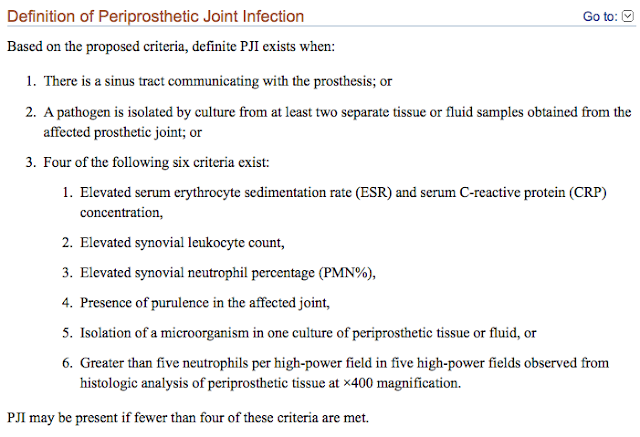These authors have defined four tiers of outcome after treatment of periprosthetic infections:
Tier 2. Infection control with the patient on suppressive antibiotic therapy
Tier 3. Need for reoperation and/or revision and/or spacer retention (assigned to subgroups A, B, C, D, E, and F basedon the type of reoperation)
A. Aseptic revision at >1 year from initiation of PJI treatment
B. Septic revision (including debridement, antibiotics, and implant retention [DAIR]) at >1 year from initiation of PJI treatment (excluding amputation, resection arthroplasty, and arthrodesis)
C. Aseptic revision at 1 year or less from initiation of PJI treatment
D. Septic revision (including DAIR) at 1 year or less from initiation of PJI treatment (excluding amputation, resection arthroplasty, and arthrodesis)
E. Amputation, resection arthroplasty, or arthrodesis
F. Retained spacer
Tier 3. Need for reoperation and/or revision and/or spacer retention (assigned to subgroups A, B, C, D, E, and F basedon the type of reoperation)
A. Aseptic revision at >1 year from initiation of PJI treatment
B. Septic revision (including debridement, antibiotics, and implant retention [DAIR]) at >1 year from initiation of PJI treatment (excluding amputation, resection arthroplasty, and arthrodesis)
C. Aseptic revision at 1 year or less from initiation of PJI treatment
D. Septic revision (including DAIR) at 1 year or less from initiation of PJI treatment (excluding amputation, resection arthroplasty, and arthrodesis)
E. Amputation, resection arthroplasty, or arthrodesis
F. Retained spacer
Tier 4. Death (assigned to subgroups A or B).
A. Death 1 year or less from initiation of PJI treatment
B. Death >1 year from initiation of PJI treatment
A. Death 1 year or less from initiation of PJI treatment
B. Death >1 year from initiation of PJI treatment
Comment: These are well thought-out definitions of outcomes after the treatment of periprosthetic infections. The challenge we face as shoulder surgeons is that patients meeting the criteria for Tier 1 "Infection Control" (see above) after treatment of Cutibacterium periprosthetic shoulder infection may have persistent or recurrent pain and stiffness - in these situations one cannot be sure if the symptoms are due to persistence of Cutibacterium in the wound. As stated in the MSIS criteria "PJI may be present if fewer than four of these criteria are met." This is particularly the case for Cutibacterium infections that are known for their "stealth" presentations months or years after a procedure.
===
We have a new set of shoulder youtubes about the shoulder, check them out at this link.
Use the "Search" box to the right to find other topics of interest to you.
You may be interested in some of our most visited web pages arthritis, total shoulder, ream and run, reverse total shoulder, CTA arthroplasty, and rotator cuff surgery as well as the 'ream and run essentials'

